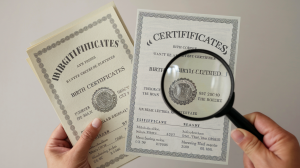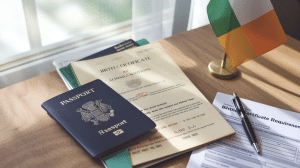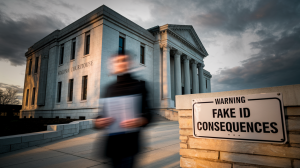
In an age where identity theft and document forgery are on the rise, knowing how to spot a fake birth certificate has become an essential skill. 🕵️♀️ Whether you’re an employer, landlord, or simply someone concerned about protecting your personal information, the ability to distinguish between genuine and counterfeit documents is crucial. But how can you tell the difference when forgers are becoming increasingly sophisticated?
The good news is that you don’t need to be a forensic expert to detect a fake birth certificate. With the right knowledge and tools, anyone can learn to identify potential red flags and verify the authenticity of this vital document. From understanding the key elements of a genuine certificate to leveraging cutting-edge technology, we’ll guide you through the process of becoming a savvy document examiner. Ready to unlock the secrets of spotting fake birth certificates? Let’s dive into the five essential steps that will transform you from a novice to a confident authenticator, before we proceed if you ever need an urgent system registered birth certificate for any legal document{ passport, driver’s license, ID card, SSN, school admission} verification purposes.
For instant assistance.
Understanding the Elements of a Genuine Birth Certificate

Essential information fields
A genuine birth certificate contains several crucial information fields that must be present and accurate. These typically include:
- Full name of the individual
- Date and time of birth
- Place of birth (city, county, state)
- Parents’ full names and places of birth
- Date of filing or registration
| Field | Description |
|---|---|
| Full Name | Legal name of the individual |
| Date of Birth | Exact date and time of birth |
| Place of Birth | City, county, and state where born |
| Parents’ Information | Full names and birthplaces of parents |
| Filing Date | Date the certificate was officially registered |
Security features
Modern birth certificates incorporate various security features to prevent counterfeiting:
- Watermarks
- Holographic images
- Raised seals
- Special inks that react to light or heat
- Microprinting
- Serial numbers
Official seals and signatures
Authentic birth certificates always include:
- Official state seal (embossed or printed)
- Signature of the registrar or other authorized official
- Name and title of the signing official
Paper quality and texture
The paper used for genuine birth certificates has specific characteristics:
- High-quality, durable paper stock
- Unique texture or feel
- Security threads or fibers embedded in the paper
- Reactive to chemical alterations
Now that we’ve covered the essential elements of a genuine birth certificate, let’s explore the visual inspection techniques that can help you spot potential forgeries.
Visual Inspection Techniques
Examining font consistency
When inspecting a birth certificate, pay close attention to the fonts used throughout the document. Genuine certificates typically use consistent fonts for all text elements. Look for:
- Uniform typeface across the document
- Consistent spacing between letters and words
- Similar font sizes for comparable information
| Font Aspect | Genuine Certificate | Potential Fake |
|---|---|---|
| Typeface | Consistent | Mixed or varied |
| Spacing | Uniform | Irregular |
| Size | Proportional | Inconsistent |
Checking for alterations or erasures
Carefully examine the document for signs of tampering:
- Look for scratches or indentations on the paper surface
- Check for discoloration or fading in specific areas
- Inspect for uneven paper thickness
Use a magnifying glass to spot minute details that might indicate alterations.
Verifying watermarks
Authentic birth certificates often feature intricate watermarks as a security measure. To verify:
- Hold the document up to a light source
- Look for a faint, embedded image or pattern
- Ensure the watermark is consistent across the entire document
- Compare with known genuine certificates from the same issuing authority
Scrutinizing the certificate’s overall layout
The layout of a birth certificate is crucial in determining its authenticity:
- Check for proper alignment of text and design elements
- Verify that all required fields are present and correctly labeled
- Ensure official seals and signatures are in their designated locations
Now that we’ve covered visual inspection techniques, let’s explore how technology can aid in the authentication process.
Technological Tools for Authentication

Using UV light to reveal hidden features
Ultraviolet (UV) light is a powerful tool for authenticating birth certificates. Many genuine documents contain hidden security features that are only visible under UV light. These can include:
- Fluorescent fibers embedded in the paper
- Invisible watermarks
- Security threads that glow under UV light
To use this method effectively, invest in a quality UV flashlight and examine the document in a dark room. Pay special attention to areas where security features are commonly placed, such as borders and backgrounds.
Employing magnification devices
Magnification tools are essential for spotting minute details that might indicate a fake birth certificate. Consider using:
| Device | Magnification | Best for |
|---|---|---|
| Loupe | 10x-20x | Fine print, microtext |
| Digital microscope | 20x-200x | Detailed paper fibers, ink analysis |
| Smartphone app | Variable | Quick on-the-go checks |
Look for inconsistencies in printing quality, especially in small text or intricate designs. Genuine documents often have crisp, clear microprinting that’s difficult to replicate.
Utilizing digital verification systems
Modern technology offers advanced solutions for birth certificate authentication:
- Online verification portals provided by government agencies
- Blockchain-based systems for tamper-proof record-keeping
- QR code scanning for instant verification
These digital tools offer quick and reliable ways to confirm a birth certificate’s authenticity by cross-referencing with official databases. However, it’s important to note that not all jurisdictions have implemented such systems, and their availability may vary.
Now that we’ve explored technological authentication methods, let’s examine some common red flags that might indicate a fake birth certificate.
Common Red Flags of Fake Birth Certificates

Misspellings and grammatical errors
One of the most telling signs of a fake birth certificate is the presence of misspellings and grammatical errors. Genuine certificates are typically produced with meticulous attention to detail. Look for:
- Incorrect spellings of common words
- Misuse of punctuation
- Improper capitalization
- Inconsistent formatting
Inconsistent dates or information
Inconsistencies in dates or personal information can be a major red flag. Pay attention to:
| Element to Check | What to Look For |
|---|---|
| Birth Date | Matches age and year of issue |
| Parents’ Ages | Reasonable for the birth year |
| Place of Birth | Consistent with issuing authority |
Low-quality printing or paper
Authentic birth certificates are printed on high-quality, security paper. Be wary of:
- Thin or flimsy paper
- Blurry or pixelated text
- Lack of security features (e.g., watermarks)
Missing or incorrect official seals
Official seals are crucial elements of genuine birth certificates. Watch out for:
- Absence of required seals
- Poorly reproduced or blurry seals
- Incorrect seal placement
Suspiciously new appearance for older certificates
Older birth certificates should show signs of age. Be cautious of:
- Pristine condition for certificates claiming to be decades old
- Lack of expected wear and tear
- Inconsistent paper quality or printing technology for the claimed issue date
Now that we’ve covered the common red flags, it’s important to know how to verify the authenticity of a birth certificate with the issuing authorities.
Verifying with Issuing Authorities
Contacting the vital records office
When in doubt about a birth certificate’s authenticity, reaching out to the vital records office is a crucial step. Here’s how to proceed:
- Locate the appropriate office:
- State-level vital records office
- County clerk’s office
- Department of Health
- Prepare necessary information:
- Full name on the certificate
- Date of birth
- Place of birth
- Parents’ names
- Contact methods:
- Phone
- In-person visit (may require appointment)
| Pros | Cons |
|---|---|
| Direct verification | Potentially time-consuming |
| Official confirmation | May involve fees |
| Access to additional details | Privacy concerns |
Using online verification services
Many states now offer online platforms for birth certificate verification:
- VitalChek: A widely used service across multiple states
- State-specific portals: Check your state’s official website
Steps for online verification:
- Create an account (if required)
- Enter certificate details
- Pay any associated fees
- Receive verification results
Understanding the limitations of third-party verification
While third-party services can be convenient, it’s important to recognize their limitations:
- Not all states participate in third-party verification systems
- Some services may not have access to the most up-to-date records
- Privacy concerns regarding sharing sensitive information
Always prioritize official channels when possible. If using a third-party service, ensure it’s reputable and authorized by the relevant government agencies. Remember, while these methods can help spot fake birth certificates, they should be part of a comprehensive authentication process that includes visual inspection and awareness of common red flags.

Spotting a fake birth certificate requires a combination of knowledge, keen observation, and the right tools. By familiarizing yourself with the elements of genuine certificates, employing visual inspection techniques, and utilizing technological authentication tools, you can significantly improve your ability to detect fraudulent documents. Remember to watch for common red flags and always verify with issuing authorities when in doubt.
Protecting the integrity of vital records is crucial for personal, legal, and societal reasons. Whether you’re an employer, government official, or simply someone concerned about document authenticity, these skills are invaluable. Stay vigilant, keep learning about the latest security features, and don’t hesitate to seek expert assistance when needed. Your ability to spot fake birth certificates contributes to maintaining the trust and security of our identification systems.








Leave a Reply